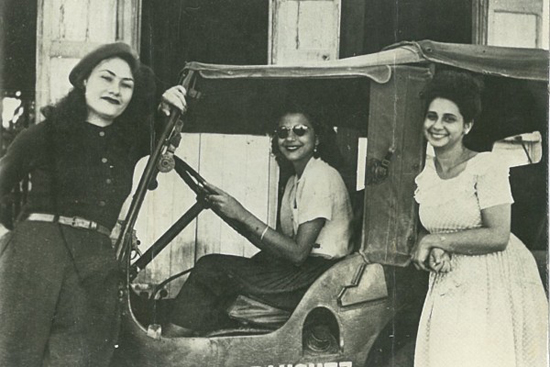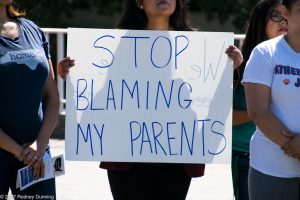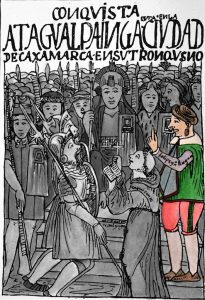The Mirabal sisters, three resilient and determined women, sought not only to serve as advocates for women’s rights, but ultimately to act as heroines for their country. Patria, Minerva, and María Teresa Mirabal lived with their family in Ojo de Agua in Salcedo Province, Dominican Republic. Their parents were successful land and business owners, and the girls lived a very conservative and humble life.1 The girls were taught the importance of education by both of their parents who worked hard to send the girls to the Colegio Inmaculada Concepcion in La Vega, a Catholic Boarding School.2

The sisters grew up during a time of intense turmoil in their country. In 1930, the Dominican Republic was placed under the rule of Generalissimo Rafael Leonidas Trujillo Molina.3 Trujillo served as the dictator of the Dominican Republic for nearly three decades, and his rule “established the most totalitarian control over his people that any Latin American country had theretofore experienced.”4 His rule included instances of bribery, murder, the disappearances of anything or anyone who challenged him, sexual advances towards a number of unwilling women, along with a number of other injustices.5

The Mirabal sisters, being the strong, intelligent, and outspoken women that they were, realized that they were unwilling to live under Trujillo’s corrupt and harmful regime. Their involvement and leadership in the revolution against Trujillo was unprecedented, not only because of the “essentially passive role [of women] in Hispanic societies,” but also due to the fear that a majority of Dominican citizens had of Trujillo.6 Still, though, three of the Mirabal sisters–Patria, Minerva, and María Teresa–along with their husbands, became symbols and leaders of political activism and opposition to Trujillo and his regime. Specifically, by 1960 the women and their husbands became synonymous with “the underground Movimiento Revolucionario 14 de Junio (MR14J) by the code name of Mariposa (butterfly)…[and] their activities to agents of Trujillo’s secret police, the dreaded SIM.”7
The sisters and their husbands were jailed multiple times for their involvement in the various protests and movements against Trujillo.8 Their movement in opposition to Trujillo came to a staggering halt on November 25, 1960. Patria, Minerva, and María Teresa were traveling back home from a jail in Puerto Plata, where their husbands were imprisoned, when they were attacked by Trujillo’s secret police. “The three women and their driver were taken out, strangled and clubbed to death. Then, in a feeble attempt to cover up the murders, their bodies were put back in the jeep and thrown off a cliff.”9 Word of the sisters’ death spread like wildfire throughout the Dominican Republic, especially among those who worked alongside Patria, Minerva, and María Teresa in opposition to Trujillo. Their deaths were described in “Trujillo’s puppet newspaper El Caribe…[as an] ‘automobile accident'”; however, “few people at home or abroad were fooled by the story,” and Trujillo’s attempt to cover up the murder was unsuccessful.10

The bravery of the women, their refusal to stay quiet or give up, and their unwavering organization efforts against Trujillo were all integral in the events that ultimately led to Trujillo’s downfall. The Mirabal sisters, now largely known as “the Mariposas,” have come to be recognized as heroines in the Dominican Republic. The country shows their appreciation and respect for the women in “virtually every Dominican [town]…[with] some commemorative marker, school, or main street bearing their names.”11 Furthermore, the women have become symbols of women and human rights worldwide. Every year, November 25, the anniversary of the sisters’ murder, is recognized as the International Day for the Elimination of Violence Against Women; November 25 is also “the beginning of 16 Days of Activism Against Gender Violence, which culminates on Human Rights Days on Dec. 10.”12
- Women in World History: A Biographical Encyclopedia, 2002, s.v. “Mirabal Sisters,” by John Haag, Ed. by Anne Commire. ↵
- Julia Alvarez, In the Time of the Butterflies (Chapel Hill, N.C.: Algonquin Books of Chapel Hill, 1994), 13. ↵
- Women in World History: A Biographical Encyclopedia, 2002, s.v. “Mirabal Sisters,” by John Haag. ↵
- Encyclopedia of Latin American History and Culture, 2008, s.v. “Trujillo Molina, Rafael Leónidas (1891-1961).” ↵
- Encyclopedia of Latin American History and Culture, 2008, s.v. “Trujillo Molina, Rafael Leónidas (1891-1961).” ↵
- Nancy Robinson, “Women’s Political Participation in the Dominican Republic: The Case of the Mirabal Sisters.” Caribbean Quarterly 52, no. 2 (January 6, 2006): 172. ↵
- Women in World History: A Biographical Encyclopedia, 2002, s.v. “Mirabal Sisters.” ↵
- Julia Alvarez, In the Time of the Butterflies (Chapel Hill, N.C.: Algonquin Books of Chapel Hill, 1994), 257-260, 337. ↵
- Nancy Robinson, “Women’s Political Participation in the Dominican Republic: The Case of the Mirabal Sisters,” Caribbean Quarterly 52, no. 2 (January 6, 2006): 172–73. ↵
- Women in World History: A Biographical Encyclopedia, 2002, s.v. “Mirabal Sisters.” ↵
- Nancy Robinson, “Women’s Political Participation in the Dominican Republic: The Case of the Mirabal Sisters,” Caribbean Quarterly 52, no. 2 (January 6, 2006): 173-74. ↵
- Charlotte Alter, “The Brutal Triple Murder Behind the International Day for the Elimination of Violence Against Women,” Time Magazine (December 2, 2014), 1. ↵



54 comments
Joshua Breard
I think that this story revolving the Mirabal sisters and their bravery is amazing and truly inspiring. It is great to read an article that portrays them as some of the bravest to ever walk this earth knowing that they had to deal with Trujillo and his regime. I think that stories like these need to be told more often as they shine light on stories that could inspire many people. Great article!
Megan Barnett
We constantly learn about different women’s rights movements in U.S. history, but it is rare that we ever hear about ones that occur in other countries, so it is nice to have a more diverse knowledge on this topic. I liked how the story included three sisters and their husbands because I thought it was interesting that the family stuck together and fought for their same beliefs.
Andrea Chavez
This is a great story of great heroines. The bravery the Maribal Sisters showed is incredible. These women represent feminism. To such great woman who would not be silenced by tyranny, it’s such an awful way to die. But at least there legacy remained and the triggered that same bravery into other people who later on followed their steps and helps free the country.
Gabriela Serrato
What a great and inspiring article. It is so hard for me to stand the many obstacles women face, and the fact that so many are murdered in order to keep them quiet. Violence against women is and always has been an issue, and I am glad that the Dominican Republic honors these women for what they stood for and their tragic end. It makes me so sad knowing what the world would be like if women were not silenced and were shown the same respect in all aspects as men. I loved reading about these women, and they will forever remain in my heart.
Amanda Figueroa
I love to read articles about women’s rights and to read about all the different women that have been fighting for equality. This is a very well written article on the Mirabal sisters who I had never heard of before. It’s very interesting to read how the sisters and husbands were jailed many times, which shows their dedication and determination to what they believe in.
Mark Martinez
An amazing and powerful article right from the start. What the Mirabal Sisters did to stand up and fight tyranny simply amazing. Even after multiple imprisonments they didn’t back down from their fight. It breaks the heart to hear how their stories end, being strangled and beaten to death. Luckily it was not written off as just some car accident and the people saw through the rouse.
Alexis Renteria
Back in my sophomore year of high school I read a book called The Brief Wondrous Life of Oscar Wao, and although its a fictional book, it talks about the life of an overweight kid growing up and dealing with the Dominican Republics experience under dictator Rafael Trujillo. I am aware that under Trujillo’s rule, the Dominican republic was being oppressed but I didn’t know that the mariposas were a major contribution to the downfall of Rafael Trujillo. Overall, this was a great article showing the bravery three sisters had to protest against a fearful leader that would do anything to scare and kill those who opposed him.
Alejandra Chavez
In my high school Spanish teachers classroom, I always sat facing a poster of the three Mariposas but I had never really given much thought as to who they might have been. Trujillo reminds me a lot of Hitler and Kim Jon Un due to his tactics of trying to eliminate anyone who went against him. I am happy that ,although it cost the lives of three beautiful souls to open the eyes of the scared citizens, there was finally something done about the dictator and it was apparent in his downfall. Very well written. The information was presented in a sequence that made it easy to follow.
Valeria Hernandez
Victoria Sanchez writes a well-organized article about the lives of three amazing leader sisters who defended their rights and set the example for millions of men and women all over the globe. Sanchez does a fantastic job at displaying the sister’s political involvement in the Dominican Republic civil rights Movements. The sisters were and are an inspiration to millions of people especially during current struggles. The sister represents a light of hope. Demonstrating that everything is possible.
Veronica Spryszynski
Very important article I read. The Mirabal sisters were so brave they risks their lives at every protest and every movement. I wish I could’ve known what happened to the three husbands after they were taken away from the sisters and imprisoned. Also for the deaths of the sisters I would not believe what the newspaper said after the evidence of what was in the car after it was found. Fortunately Trujillos fall came and a non-corrupt leader came in his place.